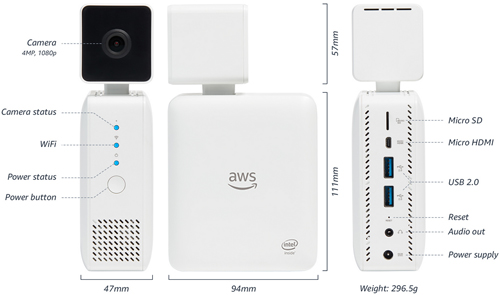News
AWS SageMaker and DeepLens Bring Machine Learning to 'Everyday' Devs
Machine learning figures heavily in a lot of Amazon Web Services (AWS) offerings, from its database products to its security solutions. However, the company has also been making a concerted effort to make machine learning more accessible to its customers and partners, regardless of their expertise level.
In October, for instance, AWS announced a collaboration with longtime cloud rival Microsoft to develop "Gluon," a deep learning library that aims to help developers, even beginners, build complex models. It also offers beginner- and intermediate-level machine learning courses for its partners. And more recently, AWS launched the Amazon ML Solutions Lab to connect data scientists with organizations that are undertaking their first machine learning projects.
At its re:Invent conference this week in Las Vegas, AWS unveiled the next milestones in its bid to democratize machine learning -- the new SageMaker machine learning platform and the DeepLens programmable camera, both of which are the product of "a long heritage of machine learning at Amazon," according to AWS CEO Andy Jassy, who introduced the products during Wednesday's re:Invent keynote.
Amazon SageMaker
Now generally available, Amazon SageMaker helps "everyday developers" easily build and deploy machine learning models, Jassy said in his keynote. SageMaker comes with pre-configured algorithms, or users can import their own. The model-training process is as easy as a single click, according to Jassy.
In a blog post Wednesday, AWS Senior Technical Evangelist Randall Hunt gave more details about SageMaker, which he said comprises three parts:
- Authoring: Zero-setup hosted Jupyter notebook IDEs for data exploration, cleaning, and preprocessing. You can run these on general instance types or GPU powered instances.
- Model Training: A distributed model building, training, and validation service. You can use built-in common supervised and unsupervised learning algorithms and frameworks or create your own training with Docker containers. The training can scale to tens of instances to support faster model building. Training data is read from S3 and model artifacts are put into S3. The model artifacts are the data dependent model parameters, not the code that allows you to make inferences from your model. This separation of concerns makes it easy to deploy Amazon SageMaker trained models to other platforms like IoT devices.
- Model Hosting: A model hosting service with HTTPs endpoints for invoking your models to get realtime inferences. These endpoints can scale to support traffic and allow you to A/B test multiple models simultaneously. Again, you can construct these endpoints using the built-in SDK or provide your own configurations with Docker images.
Each component can be used alone or in combination, Hunt said.
SageMaker is currently available out of AWS' Northern Virginia, Oregon, Ohio and Ireland regions. More information, including pricing, is available here.
AWS DeepLens
Jassy also unveiled a new edge device called AWS DeepLens that lets developers build machine learning models that incorporate real-world objects, such as faces and scenes.
DeepLens is a portable, Wi-Fi-enabled video camera with a 4MP lens, 1080P video support and a 2-D microphone array. It runs on an Intel Atom processor with capacity for 8GB of RAM and 16GB of expandable memory. It also comes with USB 2.0, HDMI and Micro SD ports. Inside, it runs the Ubuntu 16.04 operating system and comes with Greengrass Core, as well as pre-trained machine learning models for image detection and recognition.
 [Click on image for larger view.] The DeepLens camera specs. (Source: AWS)
[Click on image for larger view.] The DeepLens camera specs. (Source: AWS)
According to AWS' announcement, DeepLens is "capable of running sophisticated deep learning computer vision models in real-time," and as many as "100 billion deep learning operations per second."
Matt Wood, general manger of AI at AWS, gave a demo of both SageMaker and DeepLens during Wednesday's keynote. Wood first showed how SageMaker can be used to build a machine learning model that gives music recommendations based on users' past song selections. Wood then fed the model into DeepLens and used the camera to create "reviews" of particular albums by simply taking pictures of his face next to the album covers. DeepLens was able identify his sentiment for each album based on his expression.
"AWS DeepLens integrates with Amazon SageMaker so that developers can train their models in the cloud with Amazon SageMaker and then deploy them to AWS DeepLens with just a few clicks in the AWS Management Console. The camera runs the models, in-real time, on the device," AWS said.
DeepLens will begin shipping in the United States in April 2018, though AWS is currently taking preorders. Pricing starts at $249.
More from AWS re:Invent 2017: